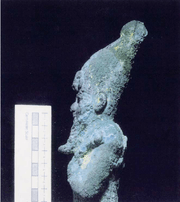Chalconatronite
| Chalconatronite | |
|---|---|
|
Chalconatronite crystals found in Bastenberg Mine, Germany | |
| General | |
| Category | Carbonate mineral |
| Formula (repeating unit) | Na2Cu(CO3)2•3(H2O) |
| Strunz classification | 5.CB.40 |
| Crystal system | Monoclinic |
| Identification | |
| Color | Blue-green, pale blue |
| Mohs scale hardness | 1 to 2 |
| Streak | Pale blue-green |
| Specific gravity | 2.27 |
Chalconatronite is a carbonate mineral that contains copper, sodium, carbon, oxygen and hydrogen, its chemical formula is Na2Cu(CO3)2•3(H2O).[1] Chalconatronite is partially soluble in water, and only decomposes, although chalconatronite is soluble while cold, in dilute acids.[2] The mineral is thought to be formed by water carrying alkali carbonates reacting with bronze. Most chalconatronite formed on bronze and silver that have been treated with either sodium sesquicarbonate or silver cyanide[3] to prevent corrosion. The name comes from the mineral's compounds, copper ("chalcos" in Greek) and natron.[4] Similar minerals include malachite, azurite, and other copper carbonates.[2] Chalconatronite has also been found and recorded in Australia and Germany.[5]
Historical Occurrence
The mineral was recorded in 1955 on three bronze artifacts from ancient Egypt, which were being held in the Fogg Art Museum at Harvard. Chalconatronite was found inside of two bronze figures (one depicting a seated Sekhmet, and another one depicting a group of cats and kittens[2][6]) from around the late Nubian Dynasty or early Saite Period. Another chalconatronite specimen was found under a bronze censer from the late Coptic Period.[2] The chalconatronite found on the censer formed over cuprite and some atacamite crystals.[2][7]
Chalconatronite was also found on iron and copper Roman armor in 1982 at a site in Chester, England.[6] Some of the mineral was found on a copper pin in St. Mark's Basilica in Venice.[8] The mineral has also been found in two different Mayan paintings.[5] Along with pseudomalachite, chalconatronite was found on an illuminated manuscript from the sixteenth century.[5] Synthetic chalconatronite could have possibly been made in ancient China as a form of pigment, named "synthetic malachite". It was made by taking copper oxide and boiling it with white alum in a "sufficient amount of water". After the result is cooled, a natron solution would be added to precipitate a synthetic form of chalconatronite, as sodium copper carbonate.[5][6]
References
- ↑ "Chalconatronite: Chalconatronite mineral information and data.". www.mindat.org. Retrieved 2017-06-16.
- 1 2 3 4 5 Gettens, R. J.; Frondel, C. (1955). "Chalconatronite: An Alteration Product on Some Ancient Egyptian Bronzes". Studies in Conservation. 2 (2): 64–75. doi:10.2307/1504919.
- ↑ "Chalconatronite - CAMEO". cameo.mfa.org. Retrieved 2017-06-17.
- ↑ Barthelmy, Dave. "Chalconatronite Mineral Data". www.webmineral.com. Retrieved 2017-06-16.
- 1 2 3 4 Eastaugh, Nicholas (2008). Pigment Compendium: A Dictionary and Optical Microscopy of Historical Pigments. Routledge. ISBN 9780750689809.
- 1 2 3 Scott, David A. (2002). Copper and Bronze in Art: Corrosion, Colorants, Conservation. Getty Publications. ISBN 9780892366385.
- ↑ Frondel, Clifford; Gettens, Rutherford J. (1955-07-08). "Chalconatronite, a New Mineral from Egypt". Science. 122 (3158): 75–76. ISSN 0036-8075. PMID 17748802. doi:10.1126/science.122.3158.75.
- ↑ E.E., Staffeldt,; Andrea, Paleni, (1978). "Chalconatronite, a new mineral from St, Mark's Basilica in Venice: alteration of a copper pin fitted on a lead ingot".

